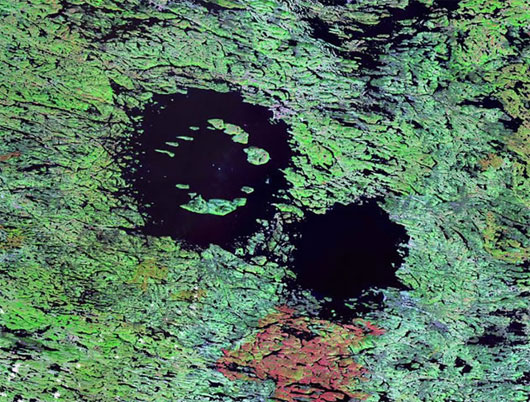Double asteroid threat
What is worse than an asteroid hitting the earth? The answer is that the twin assassins, only the simultaneous attack of the double asteroid system.
Imagine that in the last part of Armageddon , the actor Bruce Willis plays a hole in an asteroid, stuffs explosives and prepares to press the detonation button to save the earth from the disaster. However, when he turned around, he spotted another asteroid clinging to the close, and its goal was also the globe. Without explosives and supporters, this mission becomes impossible in accordance with Hollywood's standards for making sci-fi movies.

Clearwater Lake in the US - a case of a double impact hole formed about 290 million years ago - (Photo: meteorite.org)
This is not just a fantasy. According to a recent study, European experts discovered the earth had been caught by a double asteroid disaster about 458 million years ago. Dr. Jens Ormo and colleagues from the Center for Astrobiology in Madrid (Spain) analyzed small plankton-like fossils in two adjacent impact craters in Sweden. The results showed that this impacted duo was formed when a double asteroid system crashed into the surface of the globe in the Ordovician era of Paleozoic.
Many astronomers say dual asteroid systems are more common than previously thought, and nearly 15% of near-earth asteroids fall into this special group. These couples form when a type of asteroid called 'pile of pebbles' (ie many rocks stick together under the influence of gravity), begin to rotate rapidly due to receiving heat from the face. God. During the rotation, a small part separates and forms the asteroid's sub-moon. However, not every double asteroid system causes a collision when it hits the earth, as these objects tend to stick together so it is difficult to create a separate dent. Since then, scientists have calculated that only about 3% of the craters on the Earth's surface can be classified as double collisions.
For his part, Dr. Ormo argues that two collisions with names named Lockne and Malingen respectively are likely to be twins. To draw this conclusion, his team used drill bits to retrieve marine fossils called chitinozoan inside impact craters, and the results of isotopic analysis showed that they appeared at the same time. The gap between the two collisions also contributed to Ormo's hypothesis. Accordingly, Lockne and Malingen are 16km apart, close enough in case two asteroids are locked together by gravity, but still far enough away for collisions to not overlap. The report of Dr. Ormo and colleagues will be presented at the upcoming astronomical conference in Texas, and will be published in Meteoritics and Planetary Science.
- The asteroid is about to fly closest to Earth in 115 years
- Asteroid 800,000km2 fly near the Earth
- A 2,000-meter asteroid could crash into Earth in the future
- Stunned to discover the secret Itokawa asteroid
- Beam photos when everything is ... cut in half
- The asteroid discovery robot is hundreds of millions of kilometers from Earth
- NASA renamed asteroid
- A double casket was excavated at a car park in England
- NEOWISE detects new asteroids
- 7 animals with two heads
- This afternoon, an asteroid will fly over the Earth
- 2012 Asteroid BX34 almost collided with the Earth
 Van Allen's belt and evidence that the Apollo 11 mission to the Moon was myth
Van Allen's belt and evidence that the Apollo 11 mission to the Moon was myth The levels of civilization in the universe (Kardashev scale)
The levels of civilization in the universe (Kardashev scale) Today Mars, the sun and the Earth are aligned
Today Mars, the sun and the Earth are aligned The Amazon owner announced a secret plan to build a space base for thousands of people
The Amazon owner announced a secret plan to build a space base for thousands of people